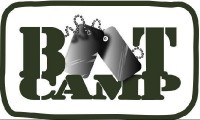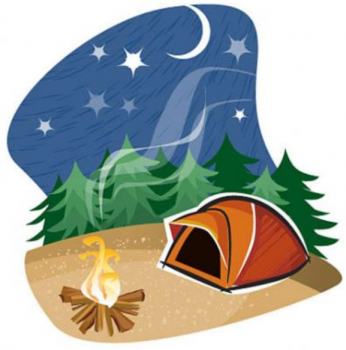 Another Section Of Our 200 Page
Another Section Of Our 200 Page
“Jump Team Boot Camp” Training Manual
AFTER SITE SURVEY: Assembling Your Tent Structures
by Bob W2IK
 Setting up a tent can seem like a complex task especially for any first-time jump team member.
Setting up a tent can seem like a complex task especially for any first-time jump team member.
Tents are a vital piece of Em-Comm gear, for sure, but many frustrated jump team members have cursed their tent as they’ve tried to set it up in the dark or during inclement weather without proper preparation.
However, once you’ve set up a tent several times, it becomes a familiar routine that can easily be repeated even in the most difficult Em-Comm conditions, and once you’ve mastered setting up one kind of tent, it will then be easier to set up other kinds of tents, be they simple or complex.
Remember that your tents (structures) are just as important as setting up your communications gear. After all, you will be living and working in them for many days. Here are some basic steps that will help you set up your tent structures quickly and efficiently.
Practice setting up your tent before you go to your duty site to deploy. Setting up your camping tent at least a couple times, directions in hand, before twilight is a good idea as you’ll never know what time of day (or night) you’ll be doing it for real. While some camping tents have simple designs, like family tents, other tents have complex designs, like dome tents, which will not be easy to assemble when it’s dark and you’re involved with other jump team duties.
 First, find an area that is flat and free of sharp objects. Clear the area of any large sticks, rocks or other debris which could cause a rip or puncture in your tent or that would be uncomfortable to sleep on. This is all part of “site survey” as discussed in an earlier blog.
First, find an area that is flat and free of sharp objects. Clear the area of any large sticks, rocks or other debris which could cause a rip or puncture in your tent or that would be uncomfortable to sleep on. This is all part of “site survey” as discussed in an earlier blog.
Spread an extra “ground tarp” (it won’t come with the tent so remember to purchase one) on the area where you are going to erect the tent. Make sure you have full coverage of the tent’s floor area.
Unpack the tent and all of its parts. Sort the parts of your camping tent into respective groups — tent stakes, tent poles, rain fly and so on — so you’re not hunting for them as you set up the tent. I never use the cheap, small metal spikes that come with the tent. Since there will be a chance that you will be in an area which has saturated soil, purchase enough long plastic tent stakes that can be purchased at most sporting goods stores.
 Unfold the tent and lay it in the respective area. Make sure it is facing the direction you desire. Remember that all your structures should be encircled like a wagon train configuration with all the doors facing inward as discussed in an earlier blog. Stake down the corners of your tent. If your tent has a ground cloth or a footprint (a tent footprint is simply a ground cloth shaped specially for your tent), set that down first.
Unfold the tent and lay it in the respective area. Make sure it is facing the direction you desire. Remember that all your structures should be encircled like a wagon train configuration with all the doors facing inward as discussed in an earlier blog. Stake down the corners of your tent. If your tent has a ground cloth or a footprint (a tent footprint is simply a ground cloth shaped specially for your tent), set that down first.
Next, stake down your tent, making sure to pull the floor of the tent fairly taut as you do so. Big tents and family tents almost always have to be staked down, but some backpacking tents do not. This is a nice feature if you plan on camping where staking might be a problem, like on slick-rock in the American Southwest, but even free-standing tents should be staked down if possible or weighted down with gear inside the tent ASAP.
Most tents have to be staked before they’ll stand up.
Connect your tent poles. Tent poles usually come in sections that you put together. To ensure that you don’t put the wrong sections together, the tent poles may be color-coded or numbered. If not, read the directions for your tent to find out how to tell the difference between different poles.
Assemble the frame of the tent. Tents come in a variety of different designs. Some tents are free-standing, like many dome tents, and use several poles that support each other, while other tents have simple two-pole designs and stand up only when the tent is staked down. However your tent works, actually erecting the frame of the tent will involve sliding the tent poles through sleeves on the outside of the tent or securing the ends of the poles in grommets at the base of the tent, and then attaching the body of the tent to the poles via clips Be careful when doing this as you do not want to puncture the tent.
Secure the rain-fly of the tent. Here’s an interesting fact about tents: camping tents usually aren’t waterproof. At least, the body of the tent itself is not waterproof. A few tents are (they’re called single-wall tents), but they’re usually expensive mountaineering tents that are uncomfortable for most normal situations. Most tents come with a waterproof cover called a rain-fly that secures over the top of the tent to protect it from the rain. If your tent has a rain-fly, secure it over the top of the tent. This usually involves fastening the corners of the rain-fly to cords that attach to the base of the tent, and may include additional clips or ties that attach to the tent poles. This type allows ventilation which makes it easier to sleep in.
Use another tarp to cover your tent structure, as you know that you’ll probably have additional rain and you do not want a leaking tent to put you off the air.
Set up each tent structure in the same way. I suggest you have a special tent for “toilet” use. These are smaller in area, yet stand about 6 feet tall. (They are often called “shower tents”.) This allows you the ability to put a portable toilet in this type of tent. Use TWO ground cloths for this tent: one under the tent itself and another INSIDE the tent just in case your members have a “poor aim”. I’d advise everyone to sit and not stand to do their “business”.
I like to use 10’x10′ “EZ UP”-type canopies for both operating and food prep areas. These canopies are usually NOT water proof so an additional tarp is required on the roof. I also use sidewalls that clip on and screened sides which allow ventilation during operation and cooking.
When you are finished deploying, carefully pack up your tents in the opposite manner in which they were assembled, BUT, when you get back home, you’ll need to rinse off and thoroughly dry every tent and tarp so mold will not grow. Fold each part the exact same way it originally came out of it’s storage bags.
